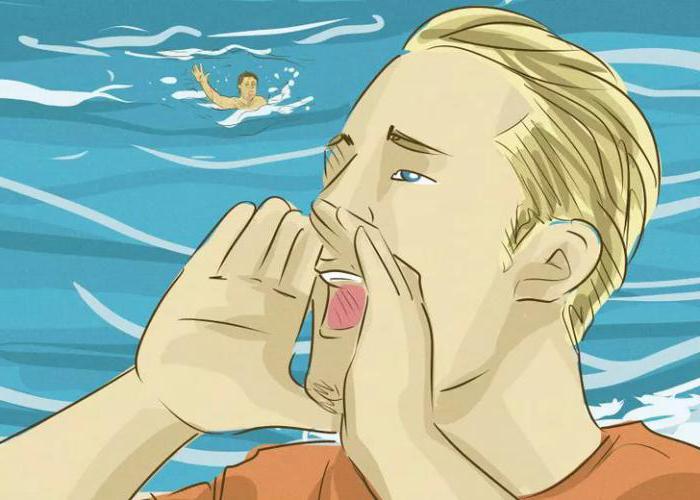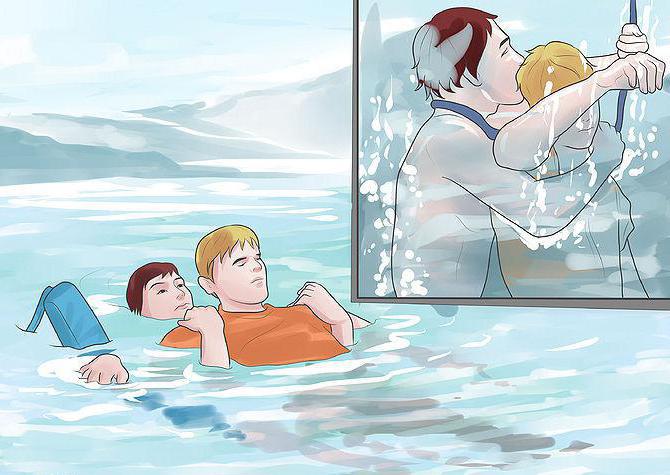How long does a person stay alive if he losesable to breathe? Brain cells remain viable under hypoxic conditions for no more than 5-6 minutes. Although when drowning in cold water this time may increase. In any case, assistance to the victim should be provided even before the arrival of the medical team. In this situation, it is the minutes that decide. That is why knowing how to assist is very important.
Not all people, however, are ready to answer the question, butall the more to show in practice how to act properly in the case of drowning. And it is very sad. For some reason, many people believe that only employees of specialized services should possess such skills; the ordinary person, far from medicine, does not need to know this. But life sometimes puts people in difficult situations. It is very scary to see a loved one die and not know how to help him.

What is drowning?
It is a life threatening condition characterized byinability to breathe as a result of human contact with water or other liquid. Frequently, the airways are filled with water, although this is not strictly necessary. Death from respiratory failure can occur, even if the lungs remain "dry." By the way, by the way, they distinguish different types of drowning.
Classification by death mechanism
Types of drowning and their characteristics:
- True drowning.It is called that because in this case water (or other liquid) enters the lungs. The pathological processes underlying true drowning differ depending on whether drowning has occurred in fresh or salt water. In the first case, water quickly penetrates from the alveoli into the bloodstream, diluting the blood and destroying red blood cells. Salt water, on the contrary, contributes to the release of plasma from the vessels, which is accompanied by thickening of the blood, as well as the development of pulmonary edema.
- Asphyxian drowning.In this case, the water does not enter the lungs, as the glottis closes, protecting the respiratory tract from the ingress of fluid into them. However, breathing still becomes impossible, because with laryngism, air is also not allowed to pass. A person dies from choking.
- Syncopal drowning. The main cause of death is reflex cardiac arrest. The lungs remain “dry”. A similar situation is possible when drowning in very cold water.

Color classification of the skin of the victim
Types of drowning by skin color:
- White asphyxia.As the name suggests, it is characterized by pronounced pallor of the skin. It occurs if the airway is not flooded with liquid. This type is most characteristic of the syncopal mechanism of drowning, when death occurs as a result of the cessation of cardiac activity.
- Синяя асфиксия.It occurs when the victim makes a breathing movement, as a result of which the lungs are filled with water. The skin becomes bluish due to severe hypoxia. Death occurs due to respiratory failure. Cardiac arrest occurs after cessation of breathing.
The appearance of the victim
Different types of drowning have certain differences in clinical manifestations.
If the victim at the time of immersionwas conscious, the scenario is as follows. A man tries to escape by swallowing water. Breathing becomes impossible, the body experiences hypoxia, as a result of which a characteristic bluish color of the skin appears. Often there is the expansion of the veins of the neck. From the mouth stands foam pink. If a person is removed from the water at the stage of agony, breathing and cardiac activity can still be maintained.

Syncopal drowning occurs on the background of a strongfright or cold shock. In the first place in the pathogenesis comes the cessation of cardiac activity. The skin is pale, there is no characteristic of other types of drowning, the discharge of fluid and foam from the nose and mouth of the victim. White asphyxia is most favorable for resuscitation, the time of clinical death with it can be significantly longer.
Basic principles of rescue when drowning
Types of drowning are diverse and require different approaches to help, but the general principles in all cases remain unchanged.
All events include 2 stages:
- Removing the injured from the water.
- Assist on shore.
How to save a drowning person?
No matter how different the typesdrowning, first aid in drowning should begin with ensuring the safety of the rescuer. A drowning person (if he is still conscious) may behave extremely inadequately. That is why, taking the victim out of the water, care should be taken. Otherwise, the rescuer risks himself to be in the role of a drowning man.

Remember: no need to climb into the water, if they themselves swim badly!

Types of drowning, first aid for drowning. Activities on the beach
There are different types of drowning, and their signs are discussed above. This knowledge is required to consider when assisting the victim.
- Everything is extremely simple, if the person extracted from the water is conscious. The main actions will be directed to warm it and calm it down.
- Если человек без сознания, первое, что нужно do - remove water from the respiratory tract. With white asphyxia, this is not necessary (the mechanism of this type of drowning is discussed above), you can immediately proceed to resuscitation.
- With the blue type of drowning, first clean the mouth andnose from algae, sand, etc. Then press on the root of the tongue, thereby determining the presence of gag reflex. Preserving the latter means that the victim is alive, so the primary task will be to remove water from the lungs and stomach. To do this, we turn the victim on his stomach, turn his head to the side, several times cause him to vomit, press on the chest. Then we repeat these actions every 5-10 minutes, until water stops from the mouth and nose. It is necessary to monitor breathing and pulse, be ready to perform resuscitation.
- If the gag reflex is absent, it is necessaryurgently check for vital functions. Most likely, they will not. Therefore, to remove water from the lungs should not spend a lot of time (no more than 1-2 minutes), and as soon as possible proceed to resuscitation.

Types of drowning. Features of resuscitation with drowning
Above, various approaches to providinghelp to the victim. There are different types of drowning, it is not surprising that they require different measures. However, cardiopulmonary resuscitation is always carried out according to a definite plan, which is not affected by the causes that led to clinical death.
What is included in the range of activities to revitalize?
- Restoration of the airway.
- Artificial respiration.
- Indirect heart massage.
No matter how different types of drowning, the firsthelp always begins with cleansing the mouth and nose of sand, algae, vomit, etc. Then water is removed from the lungs. To this end, the victim should be turned face down and lay his stomach on his knee. The head, therefore, will be lower than the body. Now you can press on the chest, stimulating the outflow of fluid from the lungs. If help is provided to a small child, you can throw it over your shoulder with your head downward or even take it by the legs and turn it over, thereby creating more favorable conditions for water to flow out of the lungs.

In conclusion
Never forget about the rules of behavior on the water. It is easier to prevent a tragedy than to try to correct it. Remember: life is given only once. Take care of her and do not play with death.









